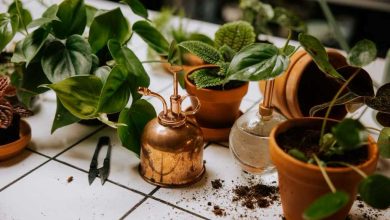
Water is the lifeblood of any garden, but it’s a precious resource that needs careful management. Whether you’re facing drought conditions or simply want to be more eco-conscious, these water-saving tips will help your garden thrive while minimizing waste.
1. Smart Plant Choices: The Foundation of a Water-Wise Garden
- Drought-Tolerant Varieties: Opt for plants that are naturally adapted to drier conditions, such as succulents, many herbs like lavender and rosemary, and native plants that have evolved to thrive in your local climate. Consider incorporating these selections into labyrinth garden ideas to enhance both aesthetic appeal and environmental sustainability. Read more about creating a drought-resistant garden that flourishes with minimal water.
- Group Plants by Water Needs: Design your garden beds to group plants with similar water requirements. This allows for targeted watering and prevents overwatering of less thirsty species.
- Xeriscaping: Consider xeriscaping – a landscaping method that prioritizes water conservation. It utilizes drought-tolerant plants, efficient irrigation, and water-retaining features like mulch and rocks.
2. Soil Health: The Key to Retaining Moisture
- Add Organic Matter: Compost, well-rotted manure, and leaf mold improve soil structure, increasing its ability to hold water like a sponge.
- Mulch, Mulch, Mulch: A thick layer of organic mulch (wood chips, shredded bark, or straw) acts as a natural barrier, reducing evaporation and keeping the soil cool and moist.
- Reduce Compaction: Avoid walking on garden beds as it compresses the soil, making it harder for water to penetrate. Use designated paths or stepping stones instead.
Related: Medicinal Plants to Grow In Your Garden
3. Efficient Watering: Target Your Efforts
- Water Deeply and Less Frequently: Encourage deep root growth by watering thoroughly but less often. This helps plants become more drought-resistant.
- Water Early in the Day: Early morning watering allows foliage to dry before evening, reducing the risk of fungal diseases.
- Use Drip Irrigation or Soaker Hoses: These systems deliver water directly to plant roots, minimizing evaporation and runoff.
- Collect Rainwater: Install rain barrels or cisterns to capture rainwater for your garden. It’s a free and sustainable water source.
4. Smart Garden Design: Work with Nature
- Rain Gardens: Create sunken areas to collect rainwater runoff. These can be planted with water-loving species and help recharge groundwater.
- Hardscaping: Use permeable materials for patios and walkways to allow water to seep into the ground instead of running off.
- Shade Strategically: Plant trees or use shade cloths to provide afternoon shade, reducing evaporation and protecting delicate plants.
5. Maintenance Matters: Conserving Water Year-Round
- Weed Regularly: Weeds compete with your plants for water and nutrients. Remove them promptly to conserve moisture.
- Check for Leaks: Repair any leaky hoses, faucets, or irrigation systems to avoid wasting water.
- Adjust Watering Schedules: Monitor weather conditions and adjust your watering schedule accordingly. Don’t water during or after rainfall.
- Maintain Your Irrigation System: Regularly inspect and maintain your drip irrigation or sprinkler system to ensure it’s working efficiently.
Beyond the Basics: Additional Water-Saving Strategies
- Greywater Recycling: Reuse water from showers, sinks, and laundry (greywater) to irrigate your garden. Consult local regulations for safe practices.
- Ollas: These unglazed clay pots buried in the ground slowly release water to plant roots, minimizing evaporation.
- Hydrogel: Water-absorbing crystals can be mixed into the soil to increase moisture retention.
Remember: Water conservation is an ongoing process. Experiment with different techniques and adapt them to your specific climate and plants. By making thoughtful choices, you can create a beautiful, thriving garden while being responsible stewards of our most precious resource.
Let me know if you’d like any of these sections expanded or if you have other questions!




